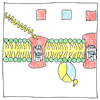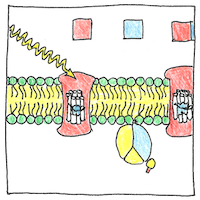George Wald
neuroscience

|
Visual phototransduction
George Wald knew that vitamin A was necessary for vision, and was able to find how it works. Vitamin A in the form of retinal combines with cell membrane protein, opsin, to form rhodopsin or its analogs. Rod and cone cells are the photoreceptors in our retinae. Rods absorb the pigment rhodopsin, and three kinds of cones absorb different rhodopsin analogs. Hit by a photon, retinal rearranges and pops out of its opsin, which starts a cascade of reactions to signal the brain. In cone cells each rhodopsin analog is sensitive to a different wavelength of light. Erythrolabe is sensitive to red; chlorolabe is sensitive to green; and cyanolabe is sensitive to blue.
Trichromatic vision
Fish and finches see four colors—red, green, blue, and ultraviolet. Primates and marsupials see three, although there are reports of humans with tetrachromatic vision. Other mammals see only two. Mantis shrimp are the super-visionaries; they have sixteen different types of cone cells. The human eyeball filters out most ultraviolet light, so if we were to see more than the usual cartoon reality, we need a rhodopsin analog that responds to an intermediate wavelength, or a lot more imagination.
Illusion of color
The world is without color, per se, only different surfaces reflecting different wavelengths and intensities of light. An illusion created by the brain, of which the retina is a part, we see color as an inherent property of the thing, even though Newton taught colors are not “Reflections of natural Bodies” but properties of light. Are they? For a poet, the external world is a book of poems. When the eye shimmers, the lake that we overlook shimmers, too.



The retina is brain tissue that is part of the central nervous system. We tend to see the world the way we are wired to see it, although the brain is marvelously flexible in regard to perception. If you optically invert your view, the brain puts it right side up again. If you take away sight, it can use sound to see your surroundings.
See also in The book of science:
Readings in wikipedia: